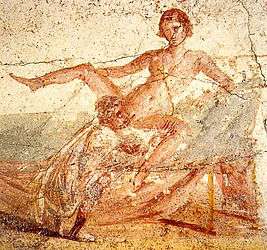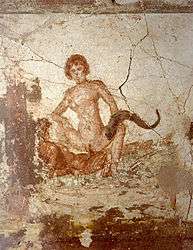Suburban Baths (Pompeii)
.jpg)
The Suburban Baths are located in Pompeii, Italy. Pompeii (located in the Italian region of Campania) was destroyed on August 24, 79 AD when Mount Vesuvius erupted, burying the entire city (along with Herculaneum) and consequently preserving them.[1]
The Suburban Baths were built around the end of the 1st century BC against the city walls north of the Porta Marina. They served as a public bath house to the residents of Pompeii They were originally discovered in 1958 and have since been excavated and restored. Excavation of the Suburban Baths have given historians a glimpse into an aspect of the social and cultural workings of Roman life in Pompeii.[2][3]
Structure of the Suburban Baths
The entrance to the Baths is through a long corridor that leads into the dressing room. Excavation of the Baths revealed only one set of dressing rooms and has led to speculation by archaeologists that both men and women shared this facility. This dressing room (known as the apodyterium) is where archaeologists discovered erotic wall paintings in the 1980s. The dressing room then led to the tepidarium (lukewarm room), followed by the calidarium (hot room).
Erotic art in the Suburban Baths
The erotic wall paintings in the Suburban Baths are the only set of such art found in a public Roman bath house. Explicit sex scenes (such as group sex and oral sex) are depicted in these paintings that cannot be easily found in collections of erotic Roman art. The paintings are located in the apodyterium and each scene is located above a numbered box. These boxes are thought to have functioned as lockers in which bathers put their clothes. It is speculated that the paintings possibly served as way for the bathers to remember the location of their box (in lieu with the numbering). The presence of these paintings in a public bath house shared by men and women gives some insight into Roman culture and suggests that people would not have found this offensive.
Gallery
-

Fresco from the Suburban baths of a 2 male and 1 female threesome.
-

Fresco from the Suburban baths depicting cunnilingus.
-

Fresco from the Suburban baths in cowgirl position
-

Part of the famous mural showing variants of sexual intercourse. Roman fresco from the Terme Suburbane in Pompeii.
-

Scene V of the famous mural showing variants of sexual intercourse. Couple in bed. The hair of the figure on the left indicates that this is a lesbian sex scene. The woman on the right wearing a fascia pectoralis lies back on a bed or a cline. The patches of dark green color are remains of the repainting of the wall.
The images are as follows: - two show a generic male-female coital scene - one woman performing fellatio on a man - one man performing cunnilingus on a woman - one lesbian duo with a phallus-shaped sexual aid or dildo - one a threesome - one foursome - one naked man with deformed, huge testicles.
Sources
- Jacobelli, 1995. Le pitture erotiche delle Terme Suburbane di Pompei. Rome, 'L'Erma' di Bretschneider. (See review by John R. Clarke's in: The American Journal of Archaeology, Vol. 100, No. 2 (April 1996), pp. 431–432.)
- Garret G. Fagan, The Genesis of the Roman Public Bath: Recent Approaches and Future Directions, American Journal of Archaeology, Vol. 105, No. 3. (Jul., 2001), pp. 403–426.
- Roger Ling, Review: Le pitture erotiche delle Terma Suburbane de Pompeii by L. Jacobelli, The Classical Review, New Ser., Vol. 46, No. 2 (1996), pp. 390–391.
- Inge Nielsen, The Architecture and Cultural History of Roman Public Baths, 1990, Aarhus University Press.
- Roy Bowen Ward, Women in Roman Baths, The Harvard Theological Review, Vol. 85, No. 2. (Apr., 1992), pp. 125–147.
References
- ↑ David Fredrick (3 October 2002). The Roman Gaze: Vision, Power, and the Body. JHU Press. pp. 152–. ISBN 978-0-8018-6961-7.
- ↑ Alison E. Cooley; M. G. L. Cooley (1 October 2013). Pompeii and Herculaneum: A Sourcebook. Routledge. pp. 60–. ISBN 978-1-134-62449-2.
- ↑ Garrett G. Fagan (2002). Bathing in Public in the Roman World. University of Michigan Press. pp. 64–. ISBN 0-472-08865-3.
Coordinates: 40°44′55″N 14°28′58″E / 40.74861°N 14.48278°E